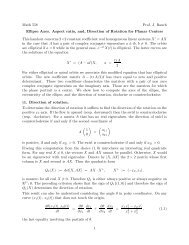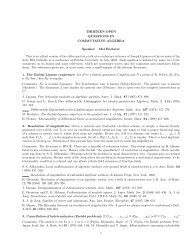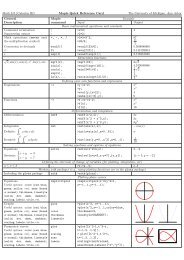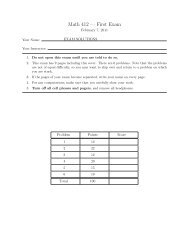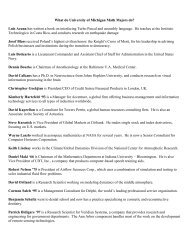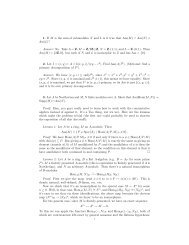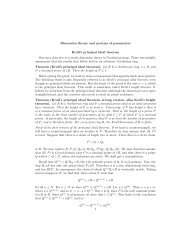Fronts Propagating with Curvature- Dependent Speed: Algorithms ...
Fronts Propagating with Curvature- Dependent Speed: Algorithms ...
Fronts Propagating with Curvature- Dependent Speed: Algorithms ...
Create successful ePaper yourself
Turn your PDF publications into a flip-book with our unique Google optimized e-Paper software.
ALGORITHMSFORSURFACEMOTIONPROBLEMS 5<br />
coordinate direction, and time step At = 0.01. Again, time is scaled by a factor of<br />
100 because the real solution goes so fast. By symmetry arguments, the evolving<br />
surface should be a sphere of decreasing radius which eventually disappears. In<br />
Fig. 13 (Figs. 13a and b), we show the collapsing sphere at various times. As easily<br />
seen, the radius decreases slowly at first and very quickly at the very end. The final<br />
shape shown (T = 6.6) is the smallest surface that can be resolved on the given<br />
mesh size.<br />
Finally, we evolve a toroidal initial surface under its mean curvature. The irmer<br />
radius is 0.25 and the outer radius is 0.5. We embed the problem in a unit cube of<br />
side length 2. and use a fairly coarse mesh of Npoint = 45 per side and time step<br />
At =Q.Ol. In Fig. 14 (Figs. 14a and b), we show the surface of the front at various<br />
times. For our particular initial surface, the torus deflates smoothly and collapses to<br />
the ring shown at T = 4.1 before it vanishes.<br />
SUMMARY<br />
We have presented a class of algorithms, called PSC schemes, for moving<br />
surfaces under their curvature. These algorithms rely on numerically solving<br />
Hamilton-Jacobi equations <strong>with</strong> viscous terms, using approximation techniques<br />
from hyperbolic conservation laws. To demonstrate our techniques, we compute the<br />
solution to a variety of surface motion problems. We hope that this tool can be<br />
applied in several areas, such as flame stretch, vortex sheet rollup, Hele-Shaw cells,<br />
and crystal growth.<br />
Copies of the computer program are available from the second author. All<br />
calculations were performed at the University of California, Berkeley and at the<br />
Lawrence Berkeley Laboratory.<br />
APPENDIX: INSTABILITY OF MARKER PARTICLES<br />
Here, we analyze in some detail the difficulties inherent in a marker particle dis-<br />
cretization of any Hamilton-Jacobi equation, and relate this to the motion of a<br />
front moving <strong>with</strong> constant speed. Consider the general Hamilton-Jacobi equation<br />
<strong>with</strong> smooth initial data $(x,,(s), 0) + ijo( The method of characteristics tells us<br />
that $, is constant along curves in x, $ space defined by



